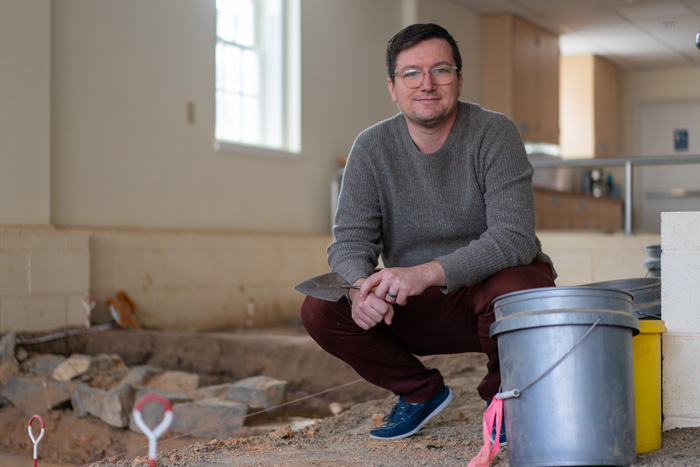Indiana Jones & the Temple of Beer and Hallucinogens

Matthew Biwer in Dickinson's Keck Archaeology Lab, a facility of the Department of Anthropology and Archaeology. Photo by Dan Loh.
OFFICE HOURS: Matthew Biwer, Assistant Professor of Anthropology and Archaeology
by Tony Moore
Assistant Professor of Anthropology and Archaeology Matthew Biwer earned his Ph.D. from the University of California, Santa Barbara. His work has been widely cited in outlets such as Gizmodo, Nature, Archaeology magazine, CNN, Ars Technica and Live Science. He teaches such courses as Environmental Archaeology and Archaeology & World Prehistory.
You’re described by those who know you best as an anthropological archaeologist and paleoethnobotanist, which seems like a weirdly technical way to talk about a friend. What does it all mean, and why is Dickinson a great home for students interested in your areas of expertise?
It really does sound very technical, doesn't it? What this means is that I analyze the garbage and other remains from past societies to investigate questions surrounding culture and what makes us human. Plants recovered from archaeological sites tell us a lot about diet, cultural beliefs surrounding food and how people lived their lives. This sort of interdisciplinary analysis fits in very well here at Dickinson, because what we are really talking about is humans and the environment. In my courses, students connect past cultures with the environment in myriad ways that are relevant the present. Issues like climate change, sustainability and inequality as seen through the lens of archaeology are very relevant to the world of today.
Some of your recent work has focused on beer and hallucinogens, but not in a “what I did last weekend in Miami” way and explored in a mature, strictly academic, anthropological milieu. What draws you to such topics (besides the obvious appeal of beer and hallucinogens)?
Topics like beer and drugs in archaeology allow our imaginations to conjure images of people in the past having huge parties and using hallucinogens in strange ways. This is definitely not the case in the past for most people. For me, what's important here are the ways these substances connect to social and political interactions. Instead of recreational use of beer and drugs as seen today, in the past these substances are often less widely available and related to spiritual rituals or political feasts. Anthropologically, we find that cultures around the world hold mind-altering substances in high regard and use them in very specific ways that may be both socially meaningful and politically powerful. Finding evidence of these practices in the past via plant remains and residues provides an intimate glimpse into the cultural importance of altered states of consciousness. From this perspective, hallucinogens are so much more than a way to have a good time.
Getting beyond my fixation with various substances, what you’re really doing in your work is exploring ancient societies and the rise and fall of empires through the lens of plant remains. I’ll just go ahead and admit that that sounds pretty cool. Is anthropology/archaeology always this cool?
Absolutely! Even though the image of archaeologists wearing fedoras and brandishing a bull whip only exists in the movies, we still manage to do some really cool and interesting research. The only catch is that instead of taking minutes to decipher a text to find the secret entrance to a tomb, we take weeks and weeks to meticulously excavate and document an excavation unit and then spend more months or years analyzing the materials so that we can find answers to the questions we are interested in. This is how archaeology really works, which I think is awesome because our careful excavations yield all kinds of evidence that we use to study the past.
TAKE THE NEXT STEPS
Published November 8, 2023